| Listing 1 - 9 of 9 |
Sort by
|
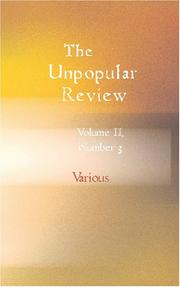
ISBN: 1281879878 9786611879877 1426490909 Year: 2007 Publisher: [Place of publication not identified] BiblioBazaar
Abstract | Keywords | Export | Availability | Bookmark
 Loading...
Loading...Choose an application
- Reference Manager
- EndNote
- RefWorks (Direct export to RefWorks)
The new social conscience is essentially a class phenomenon. While it pretends to the rle of inner monitor and guide to conduct for all mankind it interprets good and evil in class terms.
Feudalism. --- Feudal tenure --- Civilization, Medieval --- Land tenure --- Land use --- Land use, Rural --- Chivalry --- Estates (Social orders)
Book
ISBN: 9781843833703 Year: 2007 Publisher: Woodbridge : Boydell & Brewer,
Abstract | Keywords | Export | Availability | Bookmark
 Loading...
Loading...Choose an application
- Reference Manager
- EndNote
- RefWorks (Direct export to RefWorks)
Landscapes --- Land tenure --- 719 --- 902 --- 911.53 --- Countryside --- Landscape --- Natural scenery --- Scenery --- Scenic landscapes --- Nature --- 902 Archeologie --- Archeologie --- 719 Natuurbescherming. Landschapsbescherming. Heemschut --- Natuurbescherming. Landschapsbescherming. Heemschut --- Agrarian tenure --- Feudal tenure --- Freehold --- Land ownership --- Land question --- Landownership --- Tenure of land --- Land use, Rural --- Real property --- Land, Nationalization of --- Landowners --- Serfdom --- History --- Cultural landscape --- Conferences - Meetings
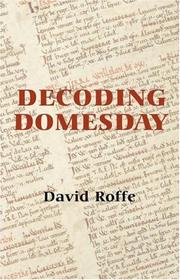
ISBN: 1782044965 1282185284 9786612185281 1846155312 1783270195 1843833077 Year: 2007 Publisher: Woodbridge ; Rochester, New York : Boydell Press,
Abstract | Keywords | Export | Availability | Bookmark
 Loading...
Loading...Choose an application
- Reference Manager
- EndNote
- RefWorks (Direct export to RefWorks)
The Domesday Book is one of our major sources for a crucial period of English history; yet it remains difficult to interpret. 'Decoding Domesday' proposes a complete re-assessment, with profound implications for our understanding of the society and economy of medieval England.
Land tenure --- History --- Domesday book. --- England --- Great Britain --- Economic conditions --- Agrarian tenure --- Feudal tenure --- Freehold --- Land ownership --- Land question --- Landownership --- Tenure of land --- Land use, Rural --- Real property --- Land, Nationalization of --- Landowners --- Serfdom --- Liber de Wintonia --- Libre de Wintonia --- Doomsday book --- King's book --- Book of Winchester --- Kniga Strashnogo suda --- Compilation Motives. --- Domesday Book. --- Domesday Inquest. --- Economic History. --- Economic Underpinning. --- English History. --- Late Eleventh Century. --- Medieval England. --- Service. --- Social History. --- Taxation. --- Tributary Economy. --- Wealth.
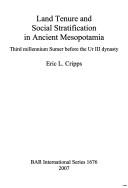
ISBN: 9781407301136 1407301136 Year: 2007 Volume: 1676 Publisher: Oxford : Archaeopress,
Abstract | Keywords | Export | Availability | Bookmark
 Loading...
Loading...Choose an application
- Reference Manager
- EndNote
- RefWorks (Direct export to RefWorks)
Sumerians --- Land tenure --- Social stratification --- Cuneiform inscriptions, Sumerian. --- Sumériens --- Propriété foncière --- Stratification sociale --- Inscriptions cunéiformes sumériennes --- Land tenure. --- Antiquities. --- Terres --- Antiquités --- Sumer --- Sumériens --- Propriété foncière --- Inscriptions cunéiformes sumériennes --- Antiquités --- Cuneiform inscriptions, Sumerian --- Accadians (Sumerians) --- Akkadians (Sumerians) --- Civilization, Sumerian --- Civilization, Assyro-Babylonian --- Ethnology --- Stratification, Social --- Equality --- Social structure --- Social classes --- Agrarian tenure --- Feudal tenure --- Freehold --- Land ownership --- Land question --- Landownership --- Tenure of land --- Land use, Rural --- Real property --- Land, Nationalization of --- Landowners --- Serfdom --- Sumerian cuneiform inscriptions --- Antiquities --- Shumer --- Sūmar --- Shūmār --- Samar --- Babylonia --- Sumeria

ISBN: 9782845868564 2845868561 Year: 2007 Publisher: Paris Karthala
Abstract | Keywords | Export | Availability | Bookmark
 Loading...
Loading...Choose an application
- Reference Manager
- EndNote
- RefWorks (Direct export to RefWorks)
Land tenure --- Land reform --- Rural development --- Natural resources --- Government policy --- Management --- Community development, Rural --- Development, Rural --- Integrated rural development --- Regional development --- Rehabilitation, Rural --- Rural community development --- Rural economic development --- Agriculture and state --- Community development --- Economic development --- Regional planning --- National resources --- Resources, Natural --- Resource-based communities --- Resource curse --- Agrarian tenure --- Feudal tenure --- Freehold --- Land ownership --- Land question --- Landownership --- Tenure of land --- Land use, Rural --- Real property --- Land, Nationalization of --- Landowners --- Serfdom --- Agrarian reform --- Economic policy --- Social policy --- Citizen participation --- Social aspects --- Economic aspects --- Land tenure - Guinea - Timbi Madina --- Land reform - Guinea - Timbi Madina --- Rural development - Government policy - Guinea - Timbi Madina --- Natural resources - Guinea - Timbi Madina - Management
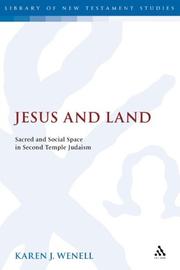
ISBN: 9780567031150 0567031152 Year: 2007 Volume: 334 Publisher: London T&T Clark
Abstract | Keywords | Export | Availability | Bookmark
 Loading...
Loading...Choose an application
- Reference Manager
- EndNote
- RefWorks (Direct export to RefWorks)
Land tenure --- Sacred space --- Judaism --- Religious aspects --- Christianity --- Biblical teaching --- History --- Social aspects --- 225.08*3 --- Holy places --- Places, Sacred --- Sacred places --- Sacred sites --- Sacred spaces --- Sites, Sacred --- Space, Sacred --- Holy, The --- Religion and geography --- Agrarian tenure --- Feudal tenure --- Freehold --- Land ownership --- Land question --- Landownership --- Tenure of land --- Land use, Rural --- Real property --- Land, Nationalization of --- Landowners --- Serfdom --- Hellenistic Judaism --- Judaism, Hellenistic --- 225.08*3 Theologie van het Nieuwe Testament: themata --- Theologie van het Nieuwe Testament: themata --- Religious aspects&delete& --- Land tenure - Religious aspects - Christianity --- Land tenure - Religious aspects - Judaism --- Land tenure - Biblical teaching --- Sacred space - History --- Sacred space - Social aspects --- Judaism - History - Post-exilic period, 586 B.C.-210 A.D
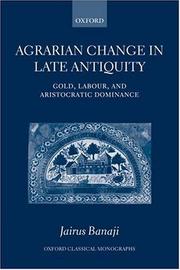
ISBN: 1281346098 0191529575 9780191529573 0199226032 0199244405 9780199226030 138303804X Year: 2007 Publisher: Oxford Oxford University Press
Abstract | Keywords | Export | Availability | Bookmark
 Loading...
Loading...Choose an application
- Reference Manager
- EndNote
- RefWorks (Direct export to RefWorks)
In this critique of Weber's ideas on antiquity, Jairus Banaji argues that the late Roman Empire saw substantial economic and social change propelled by the widely circulated stable gold coinage and a growing aristocracy.
Land tenure --- Administration of estates --- Administration --- Estates, Administration of --- Real property --- Agrarian tenure --- Feudal tenure --- Freehold --- Land ownership --- Land question --- Landownership --- Tenure of land --- Land use, Rural --- Land, Nationalization of --- Landowners --- Serfdom --- Rome --- Byzantine Empire --- Europe --- Byzantium (Empire) --- Vizantii︠a︡ --- Bajo Imperio --- Bizancjum --- Byzantinē Autokratoria --- Vyzantinon Kratos --- Vyzantinē Autokratoria --- Impero bizantino --- Bizantia --- History --- Economic conditions --- Economic conditions. --- Aristocracy (Social class) --- Propriété foncière --- Aristocratie (Classe sociale) --- Histoire --- Empire byzantin --- Conditions économiques --- Land tenure - Byzantine Empire. --- Administration of estates - Rome. --- Administration of estates - Byzantine Empire. --- Land reform --- Monetary policy --- Rural conditions. --- Social conditions.
Book
ISBN: 9783039111947 3039111949 Year: 2007 Volume: 12 Publisher: Bern Lang
Abstract | Keywords | Export | Availability | Bookmark
 Loading...
Loading...Choose an application
- Reference Manager
- EndNote
- RefWorks (Direct export to RefWorks)
Juristic acts --- Land tenure --- Written communication --- History --- Ategawa no Shō (Japan) --- Kongōbuji (Kōya-chō, Japan) --- Sources. --- Archives. --- Shimizu-chō Region (Japan) --- J4700.30 --- J4700.40 --- J5509 --- J5009 --- Japan: Law and jurisprudence -- history -- Heian period (794-1185) --- Japan: Law and jurisprudence -- history -- Kamakura period, Yoshino (1185-1392) and Chūsei in general (1185-1600) --- Japan: Literature -- theory, methodology and philosophy --- Japan: Language -- theory, methodology and philosophy --- Written discourse --- Written language --- Communication --- Discourse analysis --- Language and languages --- Visual communication --- Agrarian tenure --- Feudal tenure --- Freehold --- Land ownership --- Land question --- Landownership --- Tenure of land --- Land use, Rural --- Real property --- Land, Nationalization of --- Landowners --- Serfdom --- Acts, Juristic --- Juristic transactions --- Transactions, Juristic --- Contracts --- Ategawa no Shō (Japan) --- Kongōbuji (Kōya-chō, Japan) --- Kongōbuji, Kōya, Japan --- Kōya-chō (Japan). --- Kōyasan Kongōbuji (Kōya-chō, Japan) --- 金剛峯寺 (高野町, Japan) --- 金剛峯寺 (Kōya-chō, Japan) --- 金剛峰寺 (Kōya-chō, Japan) --- Shimizu-chō Region (Japan)
Book
ISBN: 2356135758 2910023958 9782910023959 Year: 2007 Volume: 14 Publisher: Pessac : Ausonius,
Abstract | Keywords | Export | Availability | Bookmark
 Loading...
Loading...Choose an application
- Reference Manager
- EndNote
- RefWorks (Direct export to RefWorks)
Bien éclairée par les cartulaires ecclésiastiques à partir des années 1070-1080, la société du Bordelais offre une organisation des pouvoirs particulière. Cette étude montre que la figure ducale, habituellement minorée par l’historiographie, peut être réévaluée. À la tête d’un domaine dont l’emprise territoriale est reconstituée, dominant un tissu seigneurial marqué par des seigneuries locales et des seigneuries châtelaines ne lui portant pas ombrage, le duc d’Aquitaine reste dans cette partie de la Gascogne, en dépit de ses absences, une figure majeure. La paysannerie libre y est importante. Le mariage d’Aliénor d’Aquitaine et d’Henri II Plantagenêt change la donne (1152). Dans les décennies qui suivent, le roi d’Angleterre et son fils, Richard Cœur de Lion, engagés dans de fréquents conflits, imposent un renforcement de leur autorité par l’introduction de nouvelles coutumes féodales, le relèvement de la fiscalité et par le biais de la paix du roi. Les liens sont renforcés avec l’aristocratie, nettement militarisée, ainsi qu’avec les communautés, requises au service militaire ou associées à la perception des revenus publics. Les années 1180 marquent l’acmé de ce premier temps du roi-duc.
History --- histoire médiévale --- duc --- société --- aristocratie --- Nobility --- Feudalism --- Nobility. --- Feudalism. --- France --- History. --- Aquitaine, House of. --- Aquitaine (France) --- Gascony (France) --- Feudal tenure --- Civilization, Medieval --- Land tenure --- Land use --- Land use, Rural --- Chivalry --- Estates (Social orders) --- Noble class --- Noble families --- Nobles (Social class) --- Peerage --- Upper class --- Aristocracy (Social class) --- Titles of honor and nobility --- Counts of Poitiers --- Counts of Poitou --- Dukes of Aquitaine --- House of Aquitaine --- Poitiers, Counts of --- Poitou, Counts of --- Bro-C'hall --- Fa-kuo --- Fa-lan-hsi --- Faguo --- Falanxi --- Falanxi Gongheguo --- Farans --- Farānsah --- França --- Francia (Republic) --- Francija --- Francja --- Francland --- Francuska --- Franis --- Franḳraykh --- Frankreich --- Frankrig --- Frankrijk --- Frankrike --- Frankryk --- Fransa --- Fransa Respublikası --- Franse --- Franse Republiek --- Frant͡ --- Frant͡s Uls --- Frant͡sii͡ --- Frantsuzskai͡a Rėspublika --- Frantsyi͡ --- Franza --- French Republic --- Frencisc Cynewīse --- Frenska republika --- Furansu --- Furansu Kyōwakoku --- Gallia --- Gallia (Republic) --- Gallikē Dēmokratia --- Hyãsia --- Parancis --- Peurancih --- Phransiya --- Pransiya --- Pransya --- Prantsusmaa --- Pʻŭrangs --- Ranska --- República Francesa --- Republica Franzesa --- Republika Francuska --- Republiḳah ha-Tsarfatit --- Republikang Pranses --- République française --- Tsarfat --- Tsorfat --- Gasconha (France) --- Gascogne (France) --- Armagnac (France) --- Landes (France : Department) --- Pyrénées-Atlantiques (France) --- Gironde (France) --- Lot-et-Garonne (France) --- Gers (France) --- Hautes-Pyrénées (France) --- Tarn-et-Garonne (France) --- Haute-Garonne (France) --- Région Aquitaine (France) --- Aquitânia (France) --- Guyenne (France) --- Nouvelle-Aquitaine (France) --- Histoire
| Listing 1 - 9 of 9 |
Sort by
|

 Search
Search Feedback
Feedback About UniCat
About UniCat  Help
Help News
News